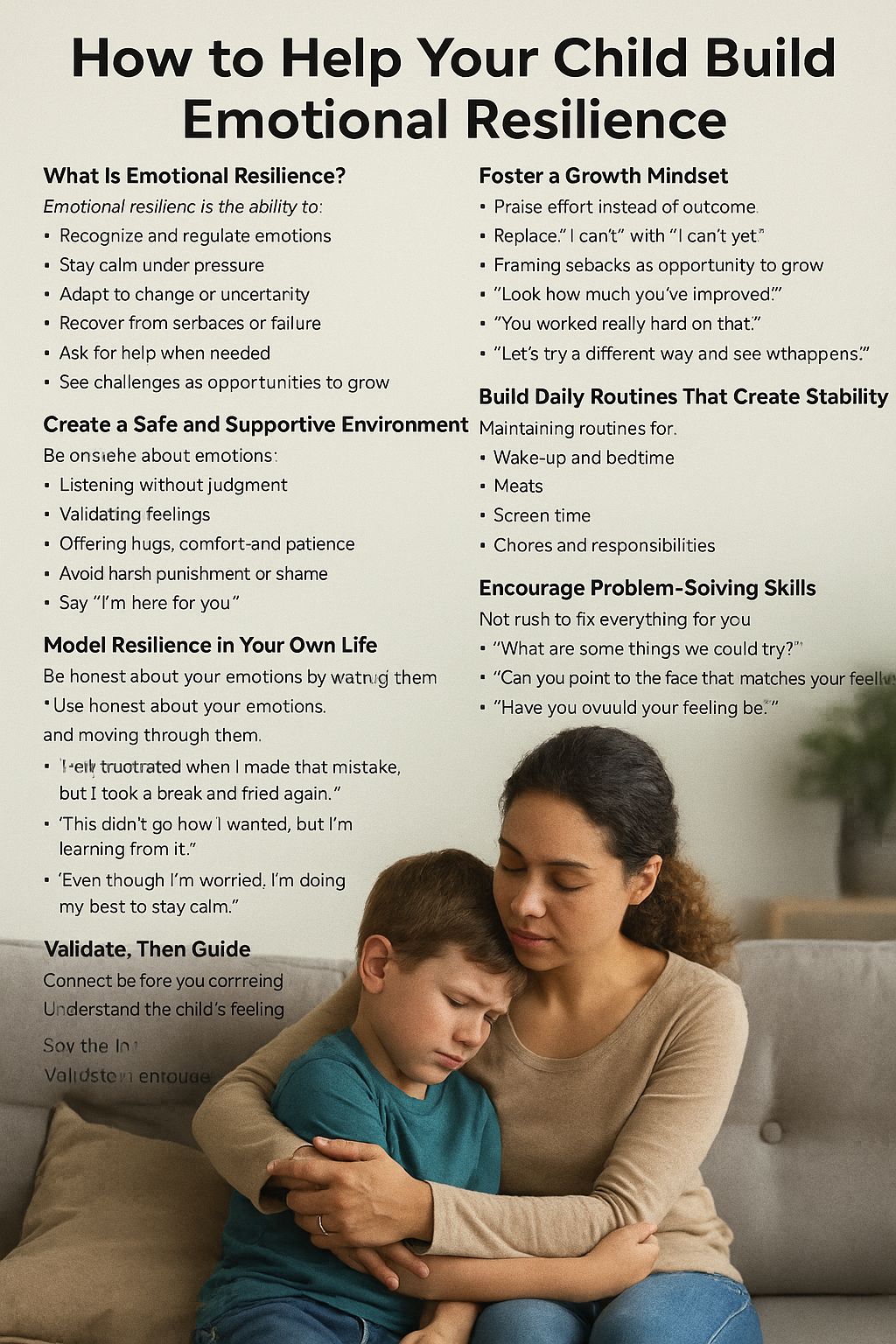Life is full of ups and downs, and emotional resilience is what helps us bounce back from challenges, stress, and disappointment. For children, resilience means being able to manage big feelings, adapt to change, and keep trying when things don’t go as planned.
Emotional resilience is not something children are born with—it’s a skill that can be taught, practiced, and strengthened over time. And as a parent or caregiver, you play a key role in helping your child grow into someone who can handle life’s emotional rollercoaster with strength and confidence.
Here’s how to nurture emotional resilience in your child from the inside out.
What Is Emotional Resilience?
Emotional resilience is the ability to:
- Recognize and regulate emotions
- Stay calm under pressure
- Adapt to change or uncertainty
- Recover from setbacks or failure
- Ask for help when needed
- See challenges as opportunities to grow
Resilient children are not emotionless—they still feel sadness, anger, fear, and frustration. The difference is that they learn how to manage those emotions and keep moving forward.
Create a Safe and Supportive Environment
Resilience begins with a sense of emotional safety. When children know they are loved and accepted no matter what, they’re more willing to take risks, make mistakes, and express difficult emotions.
You can create this safe space by:
- Listening without judgment
- Validating their feelings
- Offering hugs, comfort, and patience
- Avoiding harsh punishment or shame
- Saying “I’m here for you” often
A secure relationship with a caring adult gives children the courage to face life’s challenges.
Model Resilience in Your Own Life
Children learn how to handle adversity by watching how you handle it.
Be honest about your own emotions, and show your child how you move through them.
Say things like:
- “I felt frustrated when I made that mistake, but I took a break and tried again.”
- “This didn’t go how I wanted, but I’m learning from it.”
- “Even though I’m worried, I’m doing my best to stay calm.”
When children see you manage your feelings with intention, they learn that resilience is possible—and normal.
Teach the Language of Emotions
Children need words to describe what they’re feeling. Emotional vocabulary helps them process their emotions and ask for help when needed.
Start with simple words: happy, sad, angry, scared, excited. Then expand to more nuanced emotions: overwhelmed, jealous, proud, disappointed, embarrassed.
Use emotion charts, books, or mirrors to help them connect words with facial expressions and body signals. Ask:
- “How does your body feel right now?”
- “Can you point to the face that matches your feeling?”
- “What color would your feeling be?”
This builds emotional awareness and the foundation for self-regulation.
Validate, Then Guide
When your child is upset, connect before you correct. Jumping straight into solutions can make them feel misunderstood.
Instead of saying:
“Stop crying. It’s not a big deal.”
Try:
“I can see this really upset you. It’s okay to feel that way. Want to talk about it?”
Once they feel heard, they’re more open to problem-solving.
Then ask:
“What could help you feel better?”
“What can we do next time this happens?”
Validation + coaching = resilience.
Encourage Problem-Solving Skills
Don’t rush to fix everything for your child. Instead, guide them to think of solutions.
Ask:
- “What are some things we could try?”
- “What do you think might happen if we do that?”
- “Have you solved a problem like this before?”
This teaches your child that challenges are part of life—and that they have the tools to face them.
Let them try their solutions, even if they’re imperfect. Every attempt builds confidence and adaptability.
Normalize Mistakes and Failure
Resilient kids understand that failure is not the opposite of success—it’s part of it.
Talk openly about mistakes:
- “It’s okay to mess up. That’s how we learn.”
- “Even adults get things wrong sometimes.”
- “You were brave to try—that matters more than the result.”
Share your own past failures and what you learned. Help your child reflect on theirs without shame or blame.
Mistakes become less scary when they’re seen as learning tools, not personal flaws.
Foster a Growth Mindset
A growth mindset is the belief that abilities and intelligence can improve with effort. It’s a key part of resilience.
Encourage this by:
- Praising effort instead of outcome
- Replacing “I can’t” with “I can’t yet”
- Talking about progress instead of perfection
- Framing setbacks as opportunities to grow
Say:
- “Look how much you’ve improved!”
- “You worked really hard on that.”
- “Let’s try a different way and see what happens.”
Children with a growth mindset are more likely to persevere through difficulties.
Build Daily Routines That Create Stability
Consistency builds a sense of control—especially during uncertain or stressful times.
Maintain routines for:
- Wake-up and bedtime
- Meals
- Screen time
- Chores and responsibilities
- Time for play and connection
Knowing what to expect helps children feel safe, which supports emotional regulation and resilience.
Encourage Emotional Coping Strategies
Teach your child healthy ways to calm themselves when overwhelmed.
Some ideas:
- Deep breathing (“Smell the flower, blow out the candle”)
- Drawing or coloring
- Listening to music
- Journaling
- Quiet time with a favorite toy or book
- Going for a walk or moving their body
- Talking to someone they trust
Practice these when your child is not upset, so they’re easier to access when emotions run high.
Resilience Is a Lifelong Superpower
Raising a resilient child doesn’t mean shielding them from pain or stress. It means equipping them to face life’s challenges with tools, support, and self-belief.
With your help, your child can learn that emotions aren’t scary, mistakes aren’t final, and they are strong enough to keep going—even when things are hard.
And that’s a gift they’ll carry with them into every stage of life.
